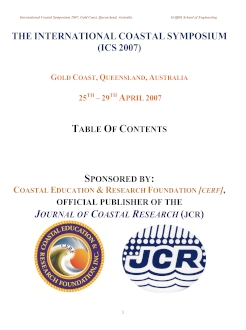Benfer, N.P., King, B.A. and Lemckert, C.J., 2007. Salinity observations in a subtropical estuarine system on the Gold Coast, Australia. Journal of Coastal Research, SI 50 (Proceedings of the 9th International Coastal Symposium), 646 – 651. Gold Coast, Australia, ISSN 0749.0208
Saltwater Creek and Coombabah Creek are branches of the Coomera River estuary situated within the subtropical Gold Coast City region, Australia, where fresh water flushing occurs during the wet season. The two creek systems are physically adjacent to each other and join at a confluence before connecting to the lower Coomera River. Saltwater Creek is 17 km long and is joined again halfway up its tidal section, via an anabranch, to Coomera River. Coombabah Creek leads upstream to Coombabah Lake, a large shallow lake ringed by mangrove swamps. In order to develop an understanding of how these systems interact with each other, in particular their salinity dynamics, at time scales ranging from tidal to annual, three field studies were undertaken.
Field measurements confirmed that the salinity dynamics of these systems were dominated by rainfall and tidal events, typical of estuaries during the ‘wet season’ in subtropical environments. In contrast, the studies found that hypersaline conditions (salinity as high as 42 psu) developed upstream during the ‘dry season’ within Coombabah Lake due to the evaporative effects of its large shallow area and adjoining mangrove swamps. Further, the data also revealed that during the dry season, Saltwater Creek’s high frequency salinity fluctuations were in-phase with tidal oscillations while Coombabah Creeks’ were out-of-phase despite their close proximity. The mechanism for this was attributed to ebb tidal currents in Coombabah Creek which flushed hypersaline water out of the lake past the confluence, and the following flood tidal currents bringing that water into Saltwater Creek. The studies also identified a low frequency oscillation in Coombabah Creeks’ salinity which was caused by the diurnal inequality in the tides.





